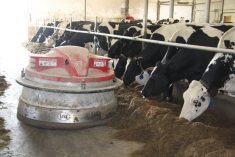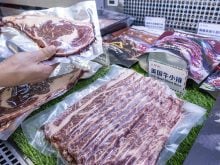SASKATOON – Josh Forrest was half an hour outside Saskatoon when his 1995 Ford Escort hit a deer.
He was driving 110 km/h while on his way to work in Carrot River, Sask. It was just after midnight and the road was dark. He didn’t see the deer until it was in his headlights.
“It happened really, really fast,’’ he said. “I saw the deer in the lights for a split second and then I couldn’t see anything.”
Read Also

Soybean market still figuring out implications of China-U.S. pact
Soybean futures had a muted reaction to the U.S. trade deal with China as the market tries to figure out the nuances of the deal.
Forrest first thought the young deer had gone through the windshield, but as he struggled to slow the car onto the side of the road, he realized the airbag had activated and hit him in face.
He flagged down a passing motorist, who volunteered to move the deer carcass into the ditch before giving Forrest a ride back to the city.
Forrest wasn’t seriously injured, although the car was totalled.
However, he said flashbacks of the deer in the headlights followed him everywhere for days after the accident. The experience has made him a more cautious driver, he added.
“I can still remember that sound and when I do, it makes me cringe. It was such a hard crunch,” he said.
“It’s made me a lot more aware when I’m driving at night, that’s for sure.”
More than 12,000 claims for collisions with wildlife are made each year in Saskatchewan, which costs Saskatchewan Government Insurance almost $33 million annually.
More than 14,000 claims involving collisions with wildlife were filed last year, costing an estimated $45.5 million in damages. Six people died as result of these crashes.
SGI has received 10,650 claims this year, and six people have died.
This year’s stats are on course with a trend that has emerged over the past five years: a steady increase in the number of accidents involving wildlife.
“Although the number (of crashes)
has risen over the years, so have the populations of deer and other wildlife,” said Kim Hambleton of SGI, whose Slow Down and Save a Buck campaign seeks to curb the number of wildlife related accidents.
“So it’s hard to tell how much higher the numbers could be without the awareness campaign.”
Adam Matichuk of the Saskatchewan Wildlife Federation, which works with SGI on the campaign, said deer populations have increased in the province the last few years.
“Towards Kindersley and Biggar, and in around those areas the populations (of deer]) are quite high,” he said. “That’s where many of those collisions occur.”
Residential developments are pushing deer out of their habitat while also restricting areas where the animals can be hunted, Matichuk said, which is one of the reasons for a rising population.
“It’s simple. You have a higher number of deer and a higher number of vehicles on the road, increasing the number of collisions,” he said.
SGI’s campaign uses highway billboards, radio and television public service announcements and a traveling bus board and trailer wrap to promote awareness and encourage drivers to slow down.
However, Hambleton said it is up to drivers to remain vigilant.
“The best advice we can give is be aware, keep looking on the sides of highways for wildlife, and to slow down in areas where there is a high populations,” she said.
“It sounds so simple, but slowing down is probably one of the best traffic safety tips we can give.”














